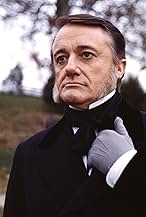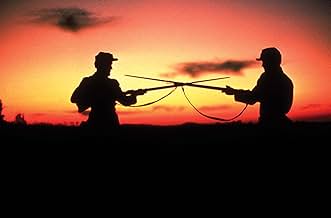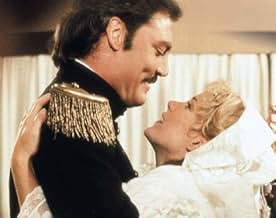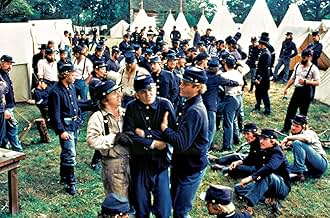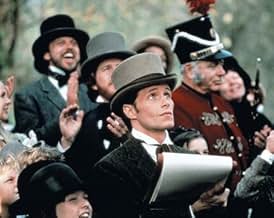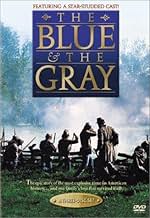AVALIAÇÃO DA IMDb
7,5/10
2 mil
SUA AVALIAÇÃO
Adicionar um enredo no seu idiomaAmerica just before and during the Civil War, as seen through the eyes of an artist correspondent.America just before and during the Civil War, as seen through the eyes of an artist correspondent.America just before and during the Civil War, as seen through the eyes of an artist correspondent.
- Indicado para 4 Primetime Emmys
- 2 vitórias e 4 indicações no total
Explorar episódios
Avaliações em destaque
This was a very good film about the Civil War. It showed the mindset of people living in the south during that era; how they were swayed into entering a futile and dangerous undertaking. The agony of war was shown at its worst, depicting the loss of the combatants as well as bystanders. Any war is horrible, but the war between the states is more so because of its utter uselessness. The waste of life and material should never have been allowed to happen. I recommend this movie; the action sequences are dramatic and well done, however, I felt some of the scenes seemed a bit underpopulated.
`The Blue and The Gray' is not a story about the Civil War. It is a long drama about a family set at the time of that war. Running more than six hours, it is indeed long. Yet, anyone interested in human relationships will find that the time is well spent and that no dead points exist. The snippets of the Civil War form a focus for the story and explain some of the relationship issues. They also remind the viewer what a truly difficult time it was for families and for our nation.
I did not see this movie when it was shown as a mini-series.I happened to like this movie because it gave a simple portrayal of what it might have been like to be a family during this period and having to face the problem of a family that was divided in its loyalties . I thought the makers of this movie followed the history of the period and gave a good presentation of the issues that the people had to deal with at the time. Of course it cannot compare to the recent Civil War Movies or even the Ken Burns series . Given the time that it was made I think it was a good portrayal of the period.
My only fault with the movie was the fact that it seemed to put the fall of Vicksburg after the Gettysburg Address. I did not understand how this was allowed to happen given the fact that it seemed to be based on Bruce Catton's work. Can anyone explain this?
My only fault with the movie was the fact that it seemed to put the fall of Vicksburg after the Gettysburg Address. I did not understand how this was allowed to happen given the fact that it seemed to be based on Bruce Catton's work. Can anyone explain this?
I first saw this mini-series while in 5th grade history class as part of our studies on the Civil War, and I thought it was excellent. Many years later, I watched it again after finding a copy of the unabridged version (all 6+ hours of it!). I wasn't sure how it would stand the test of time (both as a 16 year old production and my own view of it, being 16 years older now) and braced myself for disappointment; however, I was very pleasantly surprised. The movie is as well done as I remembered it.
It's an engrossing movie that gives an honest, frank look at the inherent moral ambiguity of war, as well as the additional consequences of the Civil War, where "brother fought brother". Although the movie certainly takes dramatic license (the main character, a young Southerner who relocates to the north after becoming disillusioned with the cruel treatment of slaves, ends up stumbling across his staunchly pro-Confederate siblings as if they're all wandering around in the same town instead of an entire country!), you can see that the film makers took great pains to portray as many perspectives as possible, to show that each and every person involved in the war was human, with their own thoughts and feelings. I'm certainly no Civil War expert, but I thought it was a very balanced portrait. What's more amazing is that the mini rarely drags despite sometimes taking a leisurely pace during its 6 hour run-time. Although we all know how the movie with ultimately end, it keeps you interested in the lives of all the characters it introduces. I thought Stacy Keach did a particularly good job despite a few hammy lines. This mini-series should definitely be on any must-see list of war films.
It's an engrossing movie that gives an honest, frank look at the inherent moral ambiguity of war, as well as the additional consequences of the Civil War, where "brother fought brother". Although the movie certainly takes dramatic license (the main character, a young Southerner who relocates to the north after becoming disillusioned with the cruel treatment of slaves, ends up stumbling across his staunchly pro-Confederate siblings as if they're all wandering around in the same town instead of an entire country!), you can see that the film makers took great pains to portray as many perspectives as possible, to show that each and every person involved in the war was human, with their own thoughts and feelings. I'm certainly no Civil War expert, but I thought it was a very balanced portrait. What's more amazing is that the mini rarely drags despite sometimes taking a leisurely pace during its 6 hour run-time. Although we all know how the movie with ultimately end, it keeps you interested in the lives of all the characters it introduces. I thought Stacy Keach did a particularly good job despite a few hammy lines. This mini-series should definitely be on any must-see list of war films.
This miniseries shows the war primarily through the eyes of a Virginian who wants to witness history but cannot commit to either side of the conflict. His new-found profession of journalism allows him to participate as a neutral observer. He is surrounded by relatives and friends on both sides, and the miniseries shows events through their eyes as well.
The human side of the war is stressed, and it excellently portrays the toll the conflict took on families.
Many of the subplots are taken from Civil War historian Bruce Catton's final work, "Reflections On The Civil War." However, none of the people in the book, including the real John Geyser, appear in the miniseries. Rather, observations made in the book are woven around the main storyline as supplementary material.
Most of the military aspects of the miniseries are laughable and bear little resemblance to reality. Due to the miniseries being done on a miniseries budget we see none of the grand scale evident in "Gettysburg" or "Glory."
Stacy Keach gives a terrific performance as Jonas Steele, the Federal special operations agent. We see from his performance a little of the decentralized, more personalized ways in which intelligence gathering and other non-standard military operations were conducted in the nineteenth century.
The miniseries ran for over six hours on CBS in 1982, but well over an hour was cut for the two-cassette video release. Get the whole treatment if you can.
The human side of the war is stressed, and it excellently portrays the toll the conflict took on families.
Many of the subplots are taken from Civil War historian Bruce Catton's final work, "Reflections On The Civil War." However, none of the people in the book, including the real John Geyser, appear in the miniseries. Rather, observations made in the book are woven around the main storyline as supplementary material.
Most of the military aspects of the miniseries are laughable and bear little resemblance to reality. Due to the miniseries being done on a miniseries budget we see none of the grand scale evident in "Gettysburg" or "Glory."
Stacy Keach gives a terrific performance as Jonas Steele, the Federal special operations agent. We see from his performance a little of the decentralized, more personalized ways in which intelligence gathering and other non-standard military operations were conducted in the nineteenth century.
The miniseries ran for over six hours on CBS in 1982, but well over an hour was cut for the two-cassette video release. Get the whole treatment if you can.
Você sabia?
- CuriosidadesSome filming took place at Prairie Grove Battlefield State Park in Arkansas. The film crew built a false side onto a historic building there, then blew it off for a special effect, assuring the State park officials that no harm would come to the building. The explosion was larger than promised, damaging the historic house's structure.
- Erros de gravaçãoWhen John Brown is hanged for the uprising at Harper's Ferry, the apple trees are in full blossom. John Brown was hanged on 2 December 1859.
- Citações
Abraham Lincoln: It's well known that the more a man speaks, the less he's understood.
- ConexõesReferenced in Saturday Night Live: Drew Barrymore/Squeeze (1982)
- Trilhas sonorasRock of Ages
Lyrics by Augustus Montague Toplady (as Augustus M. Toplady)
Music by Thomas Hastings
Principais escolhas
Faça login para avaliar e ver a lista de recomendações personalizadas
- How many seasons does The Blue and the Gray have?Fornecido pela Alexa
Detalhes
- Data de lançamento
- País de origem
- Idioma
- Também conhecido como
- Die Blauen und die Grauen
- Locações de filme
- Empresas de produção
- Consulte mais créditos da empresa na IMDbPro
Contribua para esta página
Sugerir uma alteração ou adicionar conteúdo ausente


